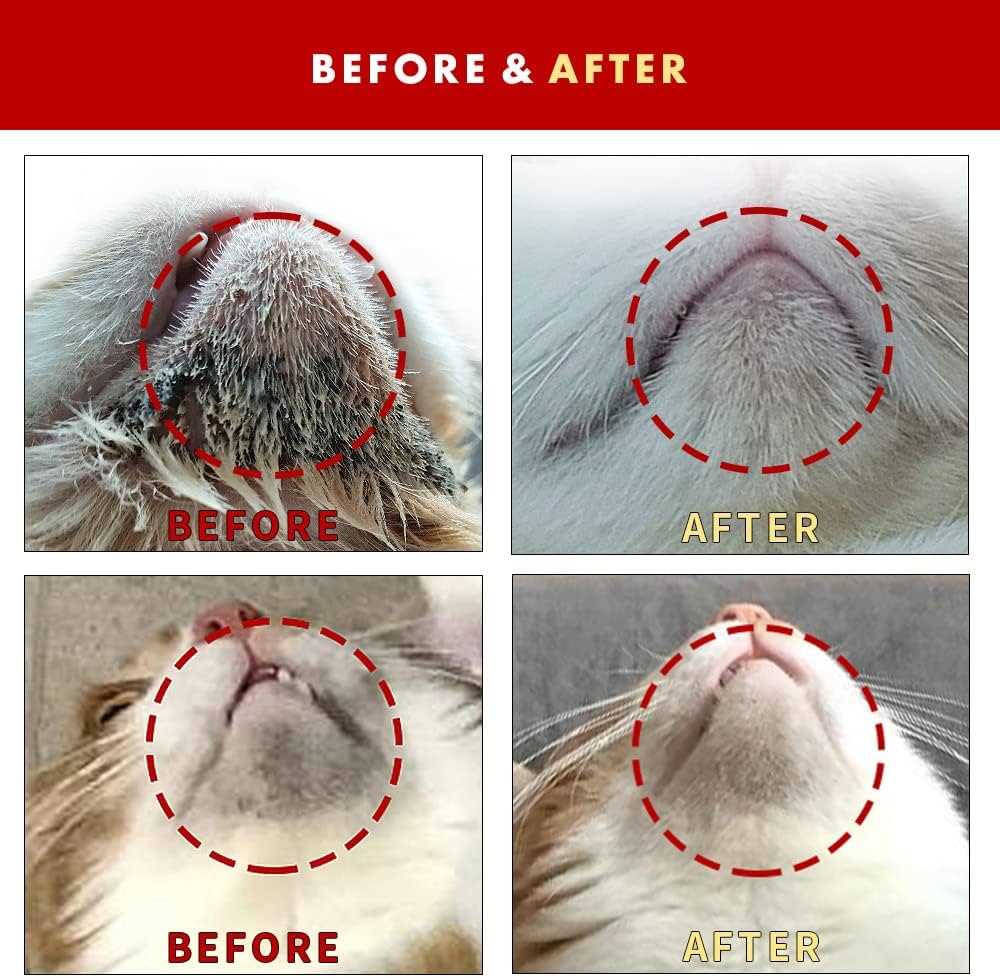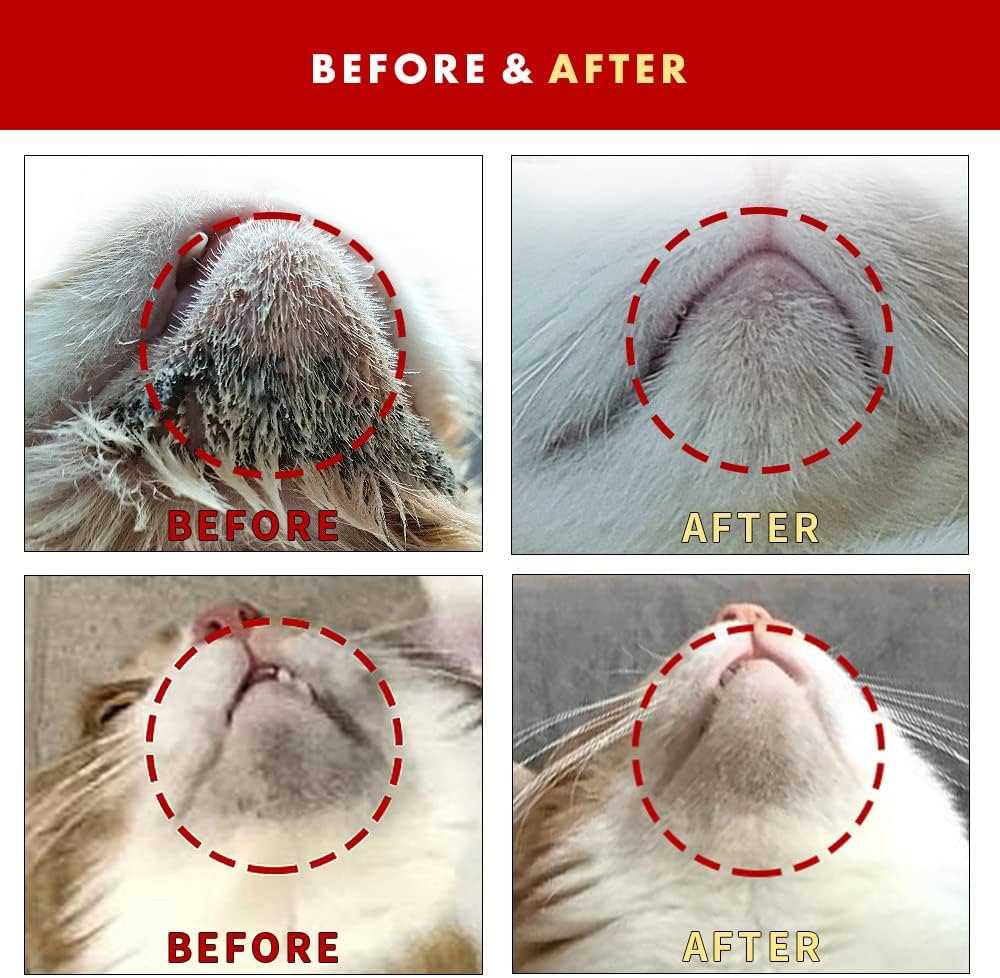



First things first: a warm, damp cloth can do wonders. Simply moisten it with water and gently wipe the affected areas on my chin and lips. This helps remove any debris and excess oil that may be contributing to the problem.
Next, consider introducing a designated feeding dish made of stainless steel or glass. Plastic bowls can harbor bacteria that exacerbate skin irritations. Clean these dishes daily with soap and water to ensure a hygienic eating environment.
Pay attention to my grooming routine. Regular brushing helps to remove loose fur and dander, reducing the chances of clogged pores. If you’re unsure about the right tools, a soft-bristled brush works well for my coat.
If the condition persists, consult with a veterinarian. They may recommend specific treatments or medicated wipes that can provide relief from these skin concerns. Always prioritize my health and comfort!
Cleaning Tips for My Skin Issues
Start with warm water and a soft cloth. Gently wipe the affected areas to loosen debris without causing irritation. Use a designated pet-friendly cleanser to help remove excess oil and dirt.
After washing, pat the skin dry with a clean towel. Avoid rubbing, as it can worsen the irritation. If any scabs or bumps are present, don’t pick at them; let them heal naturally.
Incorporate an antibacterial solution if needed. My favorite is a diluted mixture of water and apple cider vinegar, which can help keep my skin balanced. Always ensure it’s safe for furry pals before applying.
Maintain a clean environment. Regularly wash my bedding and toys to minimize bacteria and dirt exposure. A tidy living space supports healthy skin and keeps me comfortable.
Monitor my diet. Quality food plays a role in overall health, including skin condition. Discuss dietary options with a veterinarian to ensure I’m getting the right nutrition.
| Step | Action |
|---|---|
| 1 | Warm water and soft cloth wipe |
| 2 | Use pet-friendly cleanser |
| 3 | Pat dry with clean towel |
| 4 | Apply diluted apple cider vinegar if necessary |
| 5 | Wash bedding and toys regularly |
| 6 | Consult vet about diet |
Regular check-ins with a vet are important if issues persist. They can provide tailored advice and treatment suggestions to keep my skin healthy and happy.
Identifying Symptoms of Feline Skin Issues

Pay attention to these signs on your face and chin area:
- Visible pimples or bumps that may appear red or inflamed.
- Crusty or scabbed skin, especially around the jawline.
- Excessive scratching or rubbing of the face against surfaces.
- Swelling in the affected areas, potentially leading to discomfort.
- Hair loss around the chin or face, indicating irritation.
- Changes in behavior, such as increased agitation or withdrawal.
If you notice any of these symptoms, it’s wise to consult with a veterinarian for proper diagnosis and treatment. Regular face checks can help catch these issues early and prevent further problems.
Gathering Necessary Cleaning Supplies
First, you need to grab a few items to tackle those pesky blemishes. Here’s what you’ll need:
- Gentle, hypoallergenic cleanser – look for something specifically formulated for sensitive skin.
- Soft washcloths or cotton pads – these are great for applying the cleanser without irritation.
- Warm water – always use lukewarm water to avoid shocking my skin.
- Antiseptic wipes or ointment – a vet-approved option can help prevent infections.
- Disposable gloves – keep things hygienic while you work on my face.
Optional Items
- Medicated shampoos – if the situation calls for extra care, consult with a vet.
- Soft brush – for gentle exfoliation, ensuring that dead skin cells are removed.
- Ear cleaner – sometimes, the ears can contribute to skin issues, so it’s handy to have.
Having these supplies ready will make the process smoother and more comfortable for both of us. Let’s keep my adorable face looking its best!
Step-by-Step Cleaning Process for Affected Areas
First, ensure your human has gathered all necessary supplies. It’s time to get to work on those pesky spots. With the warm water and a gentle soap or solution ready, my human should soak a clean cloth in the mixture.
Next, they must gently wipe the affected areas. It’s crucial to apply minimal pressure to avoid discomfort. A soft touch helps remove dirt and oils without causing irritation.
After that, rinse the cloth with clean water and wipe off any soap residue. This step is key to ensuring that nothing remains that could irritate my skin.
Once that’s done, my human should dry the area with a separate, clean towel. Patting rather than rubbing is the way to go–gentleness is the secret!
Finally, check in with the human to see if they need to apply any ointments or treatments recommended by the vet. Keeping track of progress is important, so they should take notes or photos if necessary.
Choosing the Right Cat-Safe Cleansing Products
For my fellow furry friends dealing with skin irritations, selecting suitable cleansing solutions is key. Look for items specifically formulated for pets, ensuring they are free from harsh chemicals and fragrances that could aggravate sensitive skin.
Opt for gentle, hypoallergenic wipes or solutions with natural ingredients such as aloe vera or chamomile. These components soothe while providing necessary cleaning without causing discomfort. Always check that the product is pH-balanced for feline skin.
Consider using a mild antibacterial solution recommended by a vet. Products with tea tree oil can be beneficial, but ensure they are diluted properly, as concentrated oils can be harmful. Always perform a patch test before full application to avoid any adverse reactions.
For convenience, pre-moistened pads designed for pet care can simplify the grooming process. Ensure they are specifically labeled as safe for use on cats. Avoid any human products, as they often contain ingredients that could be toxic to us.
Stay away from anything containing alcohol, hydrogen peroxide, or strong detergents. Your safety comes first, so always read labels carefully. If unsure, consulting with a veterinarian can help identify the best options tailored to individual needs.
When to Consult a Veterinarian

If I notice persistent swelling or redness around my chin that doesn’t improve after home treatments, it’s time to seek help. Unusual bumps or lesions that seem painful indicate a deeper issue, warranting a professional assessment.
Foul odors coming from my mouth or skin can signal infection. If I experience excessive scratching or if my behavior changes, such as becoming more withdrawn or irritable, that’s a clear sign to reach out for expert advice.
When the affected area begins to bleed or ooze, immediate veterinary attention is necessary. If my human observes any signs of fever or lethargy, it’s critical to schedule an appointment without delay.
Monitoring my eating and drinking habits is also important; any noticeable changes should prompt a visit to the clinic. A veterinarian can provide a precise diagnosis and recommend a tailored treatment plan to ensure my comfort and well-being.
Preventing Future Breakouts in Cats
Regularly clean feeding bowls and water dishes to minimize bacteria buildup. Use stainless steel or ceramic options, as plastic can harbor germs. Ensure these are washed daily with hot, soapy water and rinsed thoroughly.
Monitor your nutrition closely. A balanced diet boosts skin health. Consider consulting your human about the best cat food for fiv cats or other high-quality options tailored for skin support.
Maintain a Clean Environment

Vacuum frequently to eliminate dust and allergens that can contribute to skin irritations. Keep my lounging areas tidy, and wash bedding regularly to ensure a clean resting place.
Limit Stress Factors
Stress can trigger flare-ups. Create a calm environment with plenty of cozy spots and interactive toys to keep me entertained. A stable routine also helps me feel secure and relaxed.
Monitoring and Maintaining Skin Health
Regularly observe my skin for any changes in texture or color. I keep an eye out for redness, swelling, or any unusual bumps that might indicate irritation. If I notice any new spots or increased oiliness, it’s essential to take action quickly. Daily inspections help catch issues early.
In addition to visual checks, I maintain a clean living environment. Keeping my bedding and resting areas free of dirt and allergens is crucial. I recommend using the best equestrian washing machines for deep cleaning soft furnishings, as they effectively remove potential irritants.
Incorporating a balanced diet is also part of my regimen. High-quality nutrition supports skin health, so I opt for food rich in omega fatty acids. These nutrients promote a healthy coat and may reduce the likelihood of skin issues.
Hydration plays a key role too. I make sure to drink enough water daily, as proper hydration is essential for maintaining skin elasticity and overall health.
Lastly, managing stress contributes to great skin. I enjoy playtime and relaxing moments to keep my stress levels low. A calm environment helps prevent flare-ups and keeps me feeling my best.









